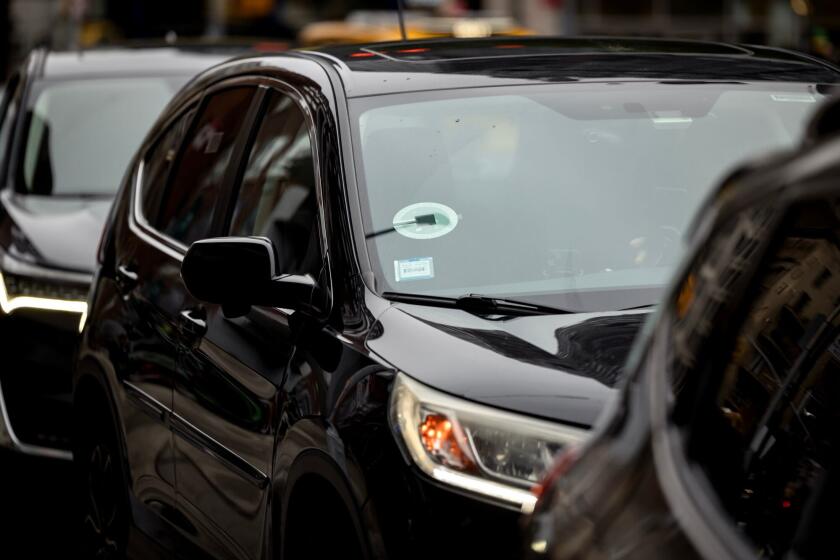Dealers Call Merger Plan Surprising but Sensible
- Share via
Southern California consumers could benefit from a merger of Daimler-Benz and Chrysler Corp. if the German luxury car maker passes its engineering and quality control standards on to Chrysler and Chrysler helps Mercedes jazz up its designs.
But little else about the combination of the two companies would affect their operations in the Southland, where both have big markets and a well-established chain of dealerships and support operations.
Chrysler and Mercedes dealers in Southern California greeted news of the merger talks with enthusiasm Wednesday, calling it surprising but eminently sensible.
“Chrysler will gain ground ... because Mercedes is known for quality and that will rub off,” said Frank McClure, general manager of Center Chrysler-Jeep in Van Nuys. “The customer will get a better product.”
But the thought that Detroit’s Big Three could soon be the Big Two is sobering to some. “It’s a little sad,” said South Bay Chrysler owner Marv Lazar, a 30-year Chrysler dealer. “For a big domestic car maker to lose its independence, that could have a lot of far-ranging implications.”
One that could benefit consumers is savings that could help keep a lid on car prices as the two companies mesh their manufacturing and distribution systems, said Nickolas Shammas, whose Downtown L.A. Motors group sells both Mercedes-Benz and Dodge.
Both Mercedes and Chrysler count Southern California as an important market area--six of the largest Mercedes-Benz dealers in the United States are in Orange and Los Angeles counties, and consumers from Santa Barbara to National City have made Chrysler’s Jeep and Ram truck lines major sellers in the region.
Each company has a design studio in the area--Chrysler Pacifica Design in Oceanside and Mercedes-Benz Advanced Design in Irvine--and the two could play off each other very well, said analyst Eric Noble of AutoPacific Inc. in Santa Ana.
“Chrysler is probably the leader in the U.S. in planning and designing vehicles for the North American market, but it is not nearly as good at building as [it is at] designing,” Noble said. “And Mercedes has a well-deserved reputation for building rolling bank vaults. If you look at the combination, it makes sense. Mercedes would get design competency for the U.S. market; Chrysler would get improved quality.”
It would take considerable time, though, for most people to notice that the two companies had merged.
“The immediate visible impact would be very minor,” Noble said. When Daimler-Benz acquired Oregon truck maker Freightliner, “You did not see a dismantling of any Freightliner operations,” he said. “All you saw was sensitive new leadership and a lot of capital investment.”
If that is the case in a Chrysler-Mercedes merger, it would be good news for several thousand Southland residents who work at the two companies’ regional facilities, and for the 132 Chrysler dealers and 24 Mercedes-Benz dealers in the region. Mergers often are accompanied by payroll reductions as overlapping operations and duplicate jobs are trimmed.
But Chrysler and Mercedes have almost no overlap in the U.S., said David Healy, automotive analyst at Burnham Securities.
A merger of the two won’t cause “a cascade of restructuring and consolidation around the world,” Healy said. “The product lines of the companies are entirely different--they’re like two ships passing in the night. Immediately at least, there will be no synergies, no merger savings, no layoffs, no consolidations, no restructurings, because there’s no overlap.”
*
Auto Powerhouse
* Chrysler Corp. and Germany’s Daimler-Benz are reportedly ready to merge in a monumental deal. A1
* It has been a long, rocky road for Chrysler, the comeback kid of American industry. D7
* Car company mergers can be very difficult. Just ask Fiat. D7
(BEGIN TEXT OF INFOBOX / INFOGRAPHIC)
A New Car Club?
A merger of Stuttgart, Germany-based luxury car maker Daimler-Benz and Chrysler Corp., the No. 3 U.S. car maker, could help each company gain a foothold in the other’s markets. A combined company would have a 7.4% share of the worldwide automotive market.
Possible benefits for Daimler-Benz:
* Would dramatically expand Mercedes-Benz’s manufacturing and dealership operations in the U.S., the world’s largest and most profitable single auto market.
* Would create opportunities for joint development, at significant cost savings, of mass-market vehicles aimed at the North American consumer.
Possible benefits for Chrysler:
* Would boost Chrysler’s virtually nonexistent position in Europe and Asia, giving it new places to sell its minivans and other vehicles.
* Might gain from the luster of the Daimler-Benz name and its luxury car lines.
* Daimler’s engineering expertise may help improve car quality.
* Would create opportunities for joint development of vehicles aimed at European customers.
* Would give Chrysler the manufacturing base in Europe that it abandoned in the 1970s amid financial crisis.
Cross-ownership by U.S. competitors
* General Motors: Negotiating to buy as much as 50% of South Korea’s Daewoo Motors. Owns 50% of Sweden’s Saab and 37.5% of Japan’s Isuzu Motors and has a 3.5% equity in Japan’s Suzuki.
* Ford Motor: Holds 33% of Japan’s Mazda Motors. Owns 17% of South Korean auto maker Kia Motor with Mazda. Owns British manufacturers Jaguar and Aston Martin. Owns 70% of Taiwan’s Lio-Ho Moto and 30% of Malaysia’s Associated Motor Industries. Holds a 20% stake in China’s Jiangling Motors.
*
“Anybody that doesn’t tell you this is a surprise is not being candid. Chrysler has had talks with BMW. This certainly was a different approach.” ADAM BAUM, analyst with automotive consulting firm IRN.
“The product lines of the companies are entirely different--they’re like two ships passing in the night. Immediately at least, there will be no synergies, no merger savings, no layoffs, no consolidations, no restructurings, because there’s no overlap.” DAVID HEALY, automotive analyst with Burnham Securities.
*
Sources: Times research, Ward’s Automotive International, Bloomberg News, wire service reports. Researched by JENNIFER OLDHAM / Los Angeles Times






